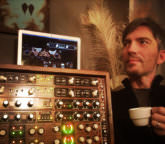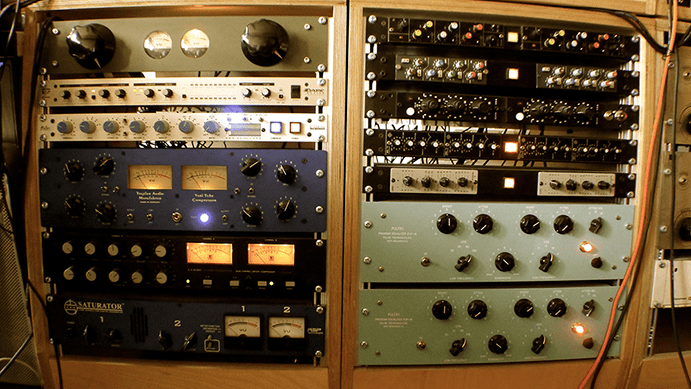Yes, saturation is a pleasing mix colouring tool, writes Gregory Scott, but its real genius is its ability to craft texturally interesting sounds that grab the listener.
 Once upon a time, when tube and ribbon microphones fed tube pre-amps, and tube pre-amps fed tube limiters and tube consoles on the way to a tube tape deck, saturation was not only ubiquitous – it was unavoidable.
Once upon a time, when tube and ribbon microphones fed tube pre-amps, and tube pre-amps fed tube limiters and tube consoles on the way to a tube tape deck, saturation was not only ubiquitous – it was unavoidable.
All of those tubes and transformers in the signal path, not to mention the tape itself, had pronounced effects on the sounds that passed through their circuits.
In particular, the transients – those super-fast bursts of energy at the start of every dynamic envelope in a sound – were shaved down a little at a time by each part of the signal chain, becoming rounder, smoother and softer with every step. This rounding of the otherwise spikiest, loudest transients is one of the main reasons that sounds which pass through a lot of analogue kit tend to be more well-behaved and quite often easier to mix.
What’s more, in order to make the signals louder than the noise and hiss created by all this gear, the engineers tended to run the levels as hot as possible, which pushed the tubes and transformers to their limits. The result? For every musical note and overtone in the original sound, new notes and overtones rose out of the depths in the form of harmonic distortions. Basic physics dictates that the harder a circuit is pushed, the more prominent the added distortions become, meaning generous amounts of harmonic distortion throughout the mix.
We call these added overtones harmonic distortions for a reason: they are harmonically – aka musically – related to the original notes and overtones within the undistorted sound. Since this harmonic distortion is inherently musical, people tend to describe its sound in terms like euphonic, rich and warm. It’s no coincidence that these are the same buzzwords used by plugin and hardware makers (ahem) in an attempt to accelerate the heart rates and stoke the desires of sound junkies everywhere.
The merging of the two aforementioned effects – transient rounding and harmonic distortion – adds up to the beautiful phenomenon that is at the heart of my own artistic and sonic life: saturation.
The new black
Back in the day, saturation was unavoidable; later, when digital took over the world of production, it became increasingly optional. Now, it’s a colour like any other, to be painted at will on the sounds in your mix. And never before has there been such an overwhelming and dizzying array of flavours and styles of saturation – in both the analogue and digital domain.
Looking at the avalanche of plugins that have rolled down the DSP mountain these past few years, it won’t have escaped your notice that many of them claim to get you closer to a coveted analogue sound. Saturation is a huge part of how they purport to get you there.
never before has there been such an overwhelming and dizzying array of flavours and styles of saturation
And when you read someone’s review of that shiny new piece of hardware in their rack, there’s a good chance they’ll talk about how beautifully it ‘colours’ the sound. Nine times out of ten, in my experience, when people talk about the colour you get just by running sound through a piece of kit, they’re mostly talking about the saturation that results from a trip into and out of the circuit.
Colour in the form of saturation is not everyone’s cup of tea – there are plenty of engineers who find its presence both annoying and undesirable.
But it is mine. I confess to a torrid and ongoing love affair with the stuff. It plays a huge part in my sound and workflow; anywhere and everywhere there’s a transformer, discrete amp, even the right chip – if it offers a flavour, odds on I’ll squeeze a little juice out of it.
A two-part game changer
But why bother? How does all this fussing with small amounts of distortion help with anything?
For starters, with all those additional harmonic overtones in play, your EQ literally has more sound to grab within a given swath of frequencies.
So if you’re looking to enhance a vocal’s forwardness in the mix by boosting 1 kHz, there’s going to be more vocal character and personality packed into every decibel boosted, because the sound itself is more dense, vibrant and electric.
Put another way: you won’t just get more vocal presence, you’ll get a more interesting vocal presence. That’s the kind of subtle thing that, when multiplied across 16 or 83 tracks, adds up to something much more compelling than a simple sum of the parts.
Secondly, in dance music, which relies so heavily on the sound of smashed transients for emotional impact (the splatting ‘doosh’ of the snare, the pumping ‘oomph’ of the kick), saturation can help solidify sounds. Shaving a fraction of the transient off the front edges of your sounds gives the compressors more room to breathe – it gives them more controlled signals to work with. This is especially true of percussive sounds. And by that I don’t just means drums; I mean stabbing keys, plucked arpeggios, basslines, exotic stringed instruments… any sound that comes on fast and hard, and where the beginning of the sound has far more amplitude than the sustain (if any).
Think of it this way: if the sound you’re feeding into a snappy compressor is already smoothed on the front edges, the device won’t have to sweat a bunch of fast impulses that are, relatively speaking, out of proportion to the bulk of the energy they’re trying to shape and control.
Shaving a few mm off the front edges of your sounds gives the compressors more room to breathe
This problem can be compounded by compressors that create an exaggerated ‘pop’ (VCA/FET types) or ‘thump’ (vari-mu types) when they attack a signal. If you’ve already got a hefty transient pulse before you apply compression, the result can be a degree of attack that’s overwhelming to the ear and, because it’s out of proportion to the rest of the envelope, actually reduces the impact of the sound, both physically and emotionally.
This is a big deal, particularly with transient-heavy drum parts, where adding compression can sometimes have the effect of lessening a sound’s impact in the mix.
Saturating a sound before compression often solves that problem because it rounds off the excessive front-end attack while redistributing more of that energy across the bulk of the sound. Saturating a sound after compression allows you to dial in even more colour.
Distorting for clarity and punch
Saturation is a formidable and often underused tool in the mixer’s arsenal. It enhances and even creates new textures in a source, and it allows for a finer degree of control over transients. As such, it can have a powerful effect on the overall clarity and punch of the mix, which in turn can make the difference between a production that merely sits at the edge of the speakers and one that physically jumps out of them.
When you use your tools like that – when you can make texturally interesting sounds and get them to jump out of the speakers and grab someone’s attention – you’ve gained tremendous ground in the battle for the listener’s hearts and, ultimately, their love for the music.
Gregory Scott is an engineer, producer and the owner of Kush Audio.

05.41 AM
I could listen to Gregory Scott talk about sound all day. He has a way with words when it comes to this subject. I would like to hear from him about EQ’s. Thanks for the excellent read.
09.30 AM
Best column on sound things around. Thanks for the inspiration Greg.
12.25 PM
Tape emulator on 2buss, crack up the input = instant L.I.E.S production
12.31 PM
Also echoing the above about words on EQ – that would be awesome.
04.46 PM
All the articles by Mr. Scott have been terrific. I’m thinking of the the practical application of saturation though. Where would it belong strategically in the signal/effects chain? Before a compressor, but where does it make the most sense in a DAW? On a return track?
Note: I have a two hardware synths, but otherwise work entirely in Ableton.
07.36 PM
Those looking for a great, affordable, saturation plug-in should check out the SDDR by Klanghelm.
02.31 AM
@Anthony .. Klanghelm is great. I think Gregory Scott himself makes some plugins and other stuff so you might want to look at those also. http://www.thehouseofkush.com/
He also has a monthly show on soundcloud that you can find links to here
https://www.facebook.com/KushAudio
02.47 AM
@Nathan .. On your question about application of saturation and where it would belong strategically in the signal/effects chain.
Saturation is color and an additive approach. In the UBK happy funtime episode 24 at 25:30 here https://soundcloud.com/ubk-happy-funtime Gregory Scott talks about Saturation and that Tone and Vibe accumulate … to be exact at 26:30
Maybe that episode will help you.
04.32 PM
great piece – thanks
10.38 PM
Great piece indeed.
05.25 PM
Great article thanks! This inspired me to try running my analog RYTM to my UBK Fatso then to my Valley People Dynamite. I’m very happy with the results!
Gregory, how does the signal path on the Tweaker work? Is the saturation/distortion before the compression? I am saving my pennies so I can get a pair 🙂